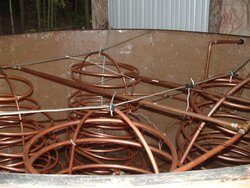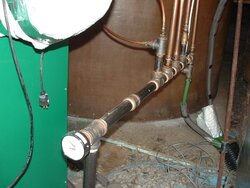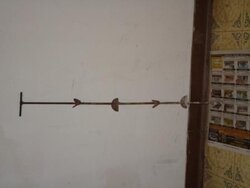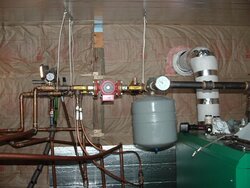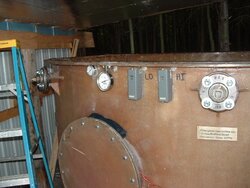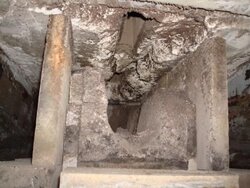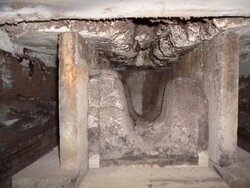Leaddogs got me thinking I also need to try a different primary adjustment. I usually always have smoke of some sort, unless in the last 3rd of the burn or so. Do you guys lose your smoke as soon as you have gasification started?
New guy - long post
- Thread starter sled_mack
- Start date
-
Active since 1995, Hearth.com is THE place on the internet for free information and advice about wood stoves, pellet stoves and other energy saving equipment.
We strive to provide opinions, articles, discussions and history related to Hearth Products and in a more general sense, energy issues.
We promote the EFFICIENT, RESPONSIBLE, CLEAN and SAFE use of all fuels, whether renewable or fossil. -
Super Cedar firestarters 30% discount Use code Hearth2024 Click here
You are using an out of date browser. It may not display this or other websites correctly.
You should upgrade or use an alternative browser.
You should upgrade or use an alternative browser.
- Status
- Not open for further replies.
Any smoke usually disappears within about 15 to 30 minutes after a cold start. When there are coals on the nozzles, sometimes there's no smoke at all on reload. I do get vapor when it's really cold.
So if I have a nice coalbed start, and good flame below, I really should see nothing then?
Well, I had to tinker with the primary, and here is whats happening so far. I definately have a much bluer flame out the bottom. I think the color blue is the hottest color. I could really feel the heat hit me. What happend (so far) is that I needed a bigger fan opening to keep the flame going. So, my stack is about 50-75 degrees higher-around 375-400. I was afraid to close the fan more than one inch or I might lose the gasification. So now it leads me to Steves original post Q- Am I getting enough water flow out of the boiler. Keep in mind to that I am using only one nozzle. Now all of this could mean nothing in the morning when I see more results-ash, water temp, so forth. Im watching my water temp, and I raised it about 6 degrees in maybe 15 minutes. Took a shower-long and hot, and it seems to be just holding steady. Now I am wondering if I lost the flame or not.
Man, these things are so tricky. At some point will we not have a EKO/Gasifier Bible? I hope so for the next guy. I still think we are in the book of Genises.
Well, I had to tinker with the primary, and here is whats happening so far. I definately have a much bluer flame out the bottom. I think the color blue is the hottest color. I could really feel the heat hit me. What happend (so far) is that I needed a bigger fan opening to keep the flame going. So, my stack is about 50-75 degrees higher-around 375-400. I was afraid to close the fan more than one inch or I might lose the gasification. So now it leads me to Steves original post Q- Am I getting enough water flow out of the boiler. Keep in mind to that I am using only one nozzle. Now all of this could mean nothing in the morning when I see more results-ash, water temp, so forth. Im watching my water temp, and I raised it about 6 degrees in maybe 15 minutes. Took a shower-long and hot, and it seems to be just holding steady. Now I am wondering if I lost the flame or not.
Man, these things are so tricky. At some point will we not have a EKO/Gasifier Bible? I hope so for the next guy. I still think we are in the book of Genises.
On a side note; tomorrow I start unhooking my cousins gaser and hook up a Central Boiler. Another post I feel...
Eric,
Just to be clear - no smoke means no visible emmissions from the stack. I still get this whispy gray smoke that dissipates within 15 ft of the stack, even this morning when there is no breeze. In the past, I've gotten up on a ladder, and it is oderless as well. Is my wood wetter than I think, and this is water vapor?
Scott,
Which way and how much did you adjust your primary?
I've got two big pumps pulling the heat from my boiler, each of which is probably moving double the water your laddomat is moving. I think you may have an issue there with that setup. Have you posted a sketch of your setup to these guys here yet? I know what I think would help, but I'd like to hear some other opinions on it as well.
How is it working out with the one nozzle blocked? In theory, it should burn twice as long. But practically, I'm guessing the wood at the other end of the firebox isn't going to fall into the coals and keep burning. It would make for a really easy start to the next fire pushing that dried wood into the coals and putting more on top!
Hooking up the CB should be a snap. The biggest issue will be how close it is to where the EKO was. Once the pipe and wireing are there, hookup is quick, filling with water can take a while, then fire it off! Good luck with that.
Second tets is in progress here. Tank was 172 this morning, it was 169 yesterday. So, we'll see if we transfer any more heat using the extra coils. 3.5 hours to wait....
Just to be clear - no smoke means no visible emmissions from the stack. I still get this whispy gray smoke that dissipates within 15 ft of the stack, even this morning when there is no breeze. In the past, I've gotten up on a ladder, and it is oderless as well. Is my wood wetter than I think, and this is water vapor?
Scott,
Which way and how much did you adjust your primary?
I've got two big pumps pulling the heat from my boiler, each of which is probably moving double the water your laddomat is moving. I think you may have an issue there with that setup. Have you posted a sketch of your setup to these guys here yet? I know what I think would help, but I'd like to hear some other opinions on it as well.
How is it working out with the one nozzle blocked? In theory, it should burn twice as long. But practically, I'm guessing the wood at the other end of the firebox isn't going to fall into the coals and keep burning. It would make for a really easy start to the next fire pushing that dried wood into the coals and putting more on top!
Hooking up the CB should be a snap. The biggest issue will be how close it is to where the EKO was. Once the pipe and wireing are there, hookup is quick, filling with water can take a while, then fire it off! Good luck with that.
Second tets is in progress here. Tank was 172 this morning, it was 169 yesterday. So, we'll see if we transfer any more heat using the extra coils. 3.5 hours to wait....
That could be. I'll get that with wood that's not as dry as I'd like. I get a fair amount of vapor when it's really cold, too. I'd say if it dissipates within 15 feet and is odorless, then it isn't smoke.
I think Scott said he cut his wood last spring. It's probably not completely dry, which I think might be part of his problem. Wet/green wood won't gasify easily, and won't stay lit, either.
I've reluctantly decided that everyone who burns wood should have a moisture meter (which I don't). It's kind of like driving without a speedometer.
I think Scott said he cut his wood last spring. It's probably not completely dry, which I think might be part of his problem. Wet/green wood won't gasify easily, and won't stay lit, either.
I've reluctantly decided that everyone who burns wood should have a moisture meter (which I don't). It's kind of like driving without a speedometer.
Eric,
You may be onto something when you said it takes a whilel for these things to react to changes! I've made no adjustments since yesterday (to keep things the same for my hx test) and this morning there was no visible smoke when I looked out about an hour after starting it up. 2 hours into the cycle still no smoke. I went out and took a peek - the lower chamber is still burning nicely and stack temps are around 250.
I hate to jump to conclusions half way through my hx test, but.... The tank is up about 9 degrees in 2 hours. It was only up about 5 at this point yesterday. I'll be keeping my fingers crossed that this is really going to be better after 4 hours.
And, since I burn based on time, and the time is such that the boiler never goes idle or empty, and the air adjustments are the same as yesterday, this may mean I can capture more heat per load of wood, too. We'll know in another 2 hours!
You may be onto something when you said it takes a whilel for these things to react to changes! I've made no adjustments since yesterday (to keep things the same for my hx test) and this morning there was no visible smoke when I looked out about an hour after starting it up. 2 hours into the cycle still no smoke. I went out and took a peek - the lower chamber is still burning nicely and stack temps are around 250.
I hate to jump to conclusions half way through my hx test, but.... The tank is up about 9 degrees in 2 hours. It was only up about 5 at this point yesterday. I'll be keeping my fingers crossed that this is really going to be better after 4 hours.
And, since I burn based on time, and the time is such that the boiler never goes idle or empty, and the air adjustments are the same as yesterday, this may mean I can capture more heat per load of wood, too. We'll know in another 2 hours!
Well, it seems I have enough pump capacity and not enough hx capacity Just checked the end of my 4 hour burn. Tank is at 188. That's up 16 degrees, 3 more than yesterday.
Just checked the end of my 4 hour burn. Tank is at 188. That's up 16 degrees, 3 more than yesterday.
And to be fair, the hotter the tank gets, the slower it wants to heat up. And, at those tank temps I noticed the boiler went into idle mode. Not sure when, but it was idling at about 3 hours and 45 minutes. That really limits the rate of heating the tank, too.
To be fair, I'd have to repeat this test next week, trying to start with the tank temp down around 160.
Two points of concern -
First - the pump off the boiler did manage to push through the pex, pump in the basement, and the two flat plate hx in the basement. I closed a valve in the basement to get a fair test with no losses to the ground.
Second - with the path the way it is in the boiler shed, the basement pump can either pull through the coils in the tank or pull through the boiler. They are essentially in parallel. Check valves won't help, because the water is always flowing the same direction.
The first problem I can solve with a valve that opens only when the pump runs. (Any recommendations on a good 1 inch valve to work off of 110 VAC?)
The second problem is a whole lot more difficult. I didn't plan on adding an automated valve there, and I have about 4 inches to work with.
Here's a thought - Does anyone make actuators to fit on the stems of 1 inch ball valves? I know for larger industrial valves it's easy to get actuators that just fit on the stem. No need to replace a valve when you want to automate one. That would make my life soooo easy!
 Just checked the end of my 4 hour burn. Tank is at 188. That's up 16 degrees, 3 more than yesterday.
Just checked the end of my 4 hour burn. Tank is at 188. That's up 16 degrees, 3 more than yesterday.And to be fair, the hotter the tank gets, the slower it wants to heat up. And, at those tank temps I noticed the boiler went into idle mode. Not sure when, but it was idling at about 3 hours and 45 minutes. That really limits the rate of heating the tank, too.
To be fair, I'd have to repeat this test next week, trying to start with the tank temp down around 160.
Two points of concern -
First - the pump off the boiler did manage to push through the pex, pump in the basement, and the two flat plate hx in the basement. I closed a valve in the basement to get a fair test with no losses to the ground.
Second - with the path the way it is in the boiler shed, the basement pump can either pull through the coils in the tank or pull through the boiler. They are essentially in parallel. Check valves won't help, because the water is always flowing the same direction.
The first problem I can solve with a valve that opens only when the pump runs. (Any recommendations on a good 1 inch valve to work off of 110 VAC?)
The second problem is a whole lot more difficult. I didn't plan on adding an automated valve there, and I have about 4 inches to work with.
Here's a thought - Does anyone make actuators to fit on the stems of 1 inch ball valves? I know for larger industrial valves it's easy to get actuators that just fit on the stem. No need to replace a valve when you want to automate one. That would make my life soooo easy!
The more I read your flow post, the more I need more flow here. I dont even know what an actuator is. Sorry cant help with that.
Well, I had really bad results closing the primary air sliders to about 3/4. This morning my tank was really cold, and the eko shut down out of wood. I havent had that since last year. Im not sure what it means. Must have burned really hot and fast to use up all that wood and not have much heat left in the tank. My tank has not been that cool for a while, and man did I have trouble getting things stable again. I am thinking not enough water flow, 6" stack instead of 8" chokes it some, and maybe the wood selection was soft stuff, but i tried to mix it as I normally do. Right now im into my best wood.
Add to that my trouble restarting. I am thinking with my house pump running continuous, maybe it keeps the Laddomats valves from working the way it should. That pump (011 taco) sits about 5 feet from the top of the Eko hot supply. Maybe it overpowers those Laddomat valves.
Eric, once you have gasification started from a new fire, you say you never lose that till the load is used up? I know dry wood is best, but im confident my wood is pretty good, but with no meter only a guess. And reading Nofossils findings on 30% wood......
Im a bit worried about adding storage, but im going to try it with yet another plumbing scheme.
Steve, how often do you need to clean your rear tubes? I am also pondering eliminating the Laddomat, go with a termovar valve that I have, and move my biggest pump (011)to the Eko loop-and move up to 1 1/4 pipe. Feed the storage tanks with an option to feed the house if I get behind. Something is making cold starts too hard, and something makes me eat wood.
The End - sequal later. Sorry for the long one, but this is sort of a hard record to look back on too.
Add to that my trouble restarting. I am thinking with my house pump running continuous, maybe it keeps the Laddomats valves from working the way it should. That pump (011 taco) sits about 5 feet from the top of the Eko hot supply. Maybe it overpowers those Laddomat valves.
Eric, once you have gasification started from a new fire, you say you never lose that till the load is used up? I know dry wood is best, but im confident my wood is pretty good, but with no meter only a guess. And reading Nofossils findings on 30% wood......
Im a bit worried about adding storage, but im going to try it with yet another plumbing scheme.
Steve, how often do you need to clean your rear tubes? I am also pondering eliminating the Laddomat, go with a termovar valve that I have, and move my biggest pump (011)to the Eko loop-and move up to 1 1/4 pipe. Feed the storage tanks with an option to feed the house if I get behind. Something is making cold starts too hard, and something makes me eat wood.
The End - sequal later. Sorry for the long one, but this is sort of a hard record to look back on too.
In my experience, it takes at least a year to get really dry wood. I think one of the symptoms of trying to burn wood that isn't sufficently dry in a gasifier would be hard starting and inconsitent gasification. But you won't know until you put a meter to your wood, so it's all a guess.
I think the 6" chimney is a major cause for concern, especially if your boiler is producing creosote, which is probably a combination of poor draft and non-dry wood.
It's hard to diagnose anything from 800 miles away, but I've burned wood for long enough to know that spring-cut wood is generally not dry. It burns better than green wood in a stove or conventional boiler or furnace, but when you get into gasifiers, I think all bets are off.
I think the 6" chimney is a major cause for concern, especially if your boiler is producing creosote, which is probably a combination of poor draft and non-dry wood.
It's hard to diagnose anything from 800 miles away, but I've burned wood for long enough to know that spring-cut wood is generally not dry. It burns better than green wood in a stove or conventional boiler or furnace, but when you get into gasifiers, I think all bets are off.
Your right. I need a meter. Tell me where to order one for 20-30 bucks. Had a buddy tell me by the way, he had a piece of wet wood he brought in, caught the water that came off of it for one day.... one gallon of water. I did not try it so who knows, but man.
What do you think of the flow thing Eric? What size of pump you runnin over there?
What do you think of the flow thing Eric? What size of pump you runnin over there?
barnartist said:Eric, once you have gasification started from a new fire, you say you never lose that till the load is used up? I know dry wood is best, but im confident my wood is pretty good, but with no meter only a guess. And reading Nofossils findings on 30% wood......
For my part, gasification combustion never stops. It even has a little flame during idle.
For the record, 30% wood looks and feels really dry. All of it was cut a year ago or more. Most of it has been stacked covered for over a year. I was surprised at the readings. I had some locust that was cut down in 1998, and has been cut to log length, split and stacked for the last six months at least. seems dry and hard. Still 30%+.
I've got a Grundfos 26-96 pushing through a 200-foot 1" loop. I also have a 3/4-inch line being circulated with a Taco 007. It's only a 100-foot loop. I'm thinking of putting a three-speed on that one, just to have one more thing to play around with.
Scott,
I forgot now - did you open or close the primary adjustments?
Before replumbing, put some sketches up here for comment. Keep in mind, I don't have any automated mixing valve. Not saying they are a bad thing, but it can be done with a hand valve, too. But, my tank never goes below 160 during normal use, so my return water is never in danger of causing condensation problems. And if the tank is down below 160, I get it back up above that pretty quickly, then close the valves.
In my experience, if the wood isn't totally dry, smaller pieces are better. Try a few loads where you split the wood smaller.
The actuator is the electrical device that sits on top of the valve body and makes it open and close when power is applied to it.
How did it go with the CB today?
I forgot now - did you open or close the primary adjustments?
Before replumbing, put some sketches up here for comment. Keep in mind, I don't have any automated mixing valve. Not saying they are a bad thing, but it can be done with a hand valve, too. But, my tank never goes below 160 during normal use, so my return water is never in danger of causing condensation problems. And if the tank is down below 160, I get it back up above that pretty quickly, then close the valves.
In my experience, if the wood isn't totally dry, smaller pieces are better. Try a few loads where you split the wood smaller.
The actuator is the electrical device that sits on top of the valve body and makes it open and close when power is applied to it.
How did it go with the CB today?
C.B. installed and really simple. I have to say, so far I am liking what I see from it, but we'll see how much wood it consumes. Myself, my cousin, my dad, and probably my daughter could fit in it. I have to also say how little smoke comes from it at idle. I get more smoke I think. Believe me I'll keep an eye on it.
I am into really good oak right now Eric. Did the old smack two pieces together and it sounds like I hit a grand slam. Nice hollow sound, but no real number to that I guess.
Before I had an automatic valve Steve, I had real problems from a cold start. I think I'll be ok by either adding a pump like you said in the eko loop, unless someone here thinks the Laddomat's pump would choke the flow from the added pump. If so I will switch to the termovar valve and eliminate the Laddomat. Maybe the Laddomat should be used on smaller sized burners, I don't know. Maybe I should post a new thread about the laddomat, see if anyone else is using one...? This is suppose to be Steves thread, maybe I hijacked it.
I am into really good oak right now Eric. Did the old smack two pieces together and it sounds like I hit a grand slam. Nice hollow sound, but no real number to that I guess.
Before I had an automatic valve Steve, I had real problems from a cold start. I think I'll be ok by either adding a pump like you said in the eko loop, unless someone here thinks the Laddomat's pump would choke the flow from the added pump. If so I will switch to the termovar valve and eliminate the Laddomat. Maybe the Laddomat should be used on smaller sized burners, I don't know. Maybe I should post a new thread about the laddomat, see if anyone else is using one...? This is suppose to be Steves thread, maybe I hijacked it.
Scott,
I don't mind the hijack, but you'll probably get more visibility on your question in another thread. Start a thread, post up a sketch of what you have and what you want, and wait for the feedback and suggestions!
If all goes well, there should be some pics here. A few of the tank and plumbing setup from when I installed everything and a few of the lower chamber from today. You can see how I have the tunnel setup and where the refractory has broken apart a little around the bottom of the nozzle. I also noticed some around the sides, too.
Edit - running into file size limits. More pics in next post. Home made turbulator on this one, too.
And, the U shaped pieces are in pieces. Each one is in several pieces, but they stack together tight enough to stay in place. I'm going to have to get some refractory bricks and just do the tunnel with those.
I don't mind the hijack, but you'll probably get more visibility on your question in another thread. Start a thread, post up a sketch of what you have and what you want, and wait for the feedback and suggestions!
If all goes well, there should be some pics here. A few of the tank and plumbing setup from when I installed everything and a few of the lower chamber from today. You can see how I have the tunnel setup and where the refractory has broken apart a little around the bottom of the nozzle. I also noticed some around the sides, too.
Edit - running into file size limits. More pics in next post. Home made turbulator on this one, too.
And, the U shaped pieces are in pieces. Each one is in several pieces, but they stack together tight enough to stay in place. I'm going to have to get some refractory bricks and just do the tunnel with those.
Attachments
Sled-Mack Daddy, I think you need some new refractory. I would be a little nervous throwing wood into the firebox. It looks like it wouldn't take much to knock the nozzle bigger. :grrr:
Each "nest" of coils has two coils. The inner coils are supplied from the boiler, the outer supply the house. Each of those coils is 60 ft of 3/4 tubing. However, I just found that I get much better results by pumping through both sets while burning. I just need an actuator for a valve so that I don't have to close it when the pumps go off.
I didn't empty all the ashes out the top, as they were still red hot. But the area around the nozzle still looks good up above. Even the nozzle itself looks fine from the bottom. If it falls through, I'm screwed, and panic will start shortly thereafter.
Anyone had to replace that lower refractory on an EKO? I'm curious how hard it is to do.
I didn't empty all the ashes out the top, as they were still red hot. But the area around the nozzle still looks good up above. Even the nozzle itself looks fine from the bottom. If it falls through, I'm screwed, and panic will start shortly thereafter.
Anyone had to replace that lower refractory on an EKO? I'm curious how hard it is to do.
Thanks for the pic's. I think I won't add the fire brick after looking at yours. It looks to me that you are getting errosion from the hot gases . My gasses don't seem to blow back up like it seems it is on yours. I don't think that the bottem fire brick is make of as high rated as the nozzel is as the nozzel doesn't show hardly any wear. The top of mine doesn't show any wear like that. But then I've only been running it this year.
I see that your tank is made from fiberglass. Do you see any problem with the high temp?
leaddog
I see that your tank is made from fiberglass. Do you see any problem with the high temp?
leaddog
I like the tank. I'm confused about the chimney. I'm a little shocked at the refractory.
I hope those firebricks on either side of the gasification trough aren't holding the refractory up. I think we discussed inspecting the secondary air tubes to make sure that all is still well in there. With that much apparent degradation to the refractory, I'd be worried that the tubes are still delivering air correctly.
Why don't you just buy new trough bricks, instead of screwing around with all that firebrick? I'd be worried that using a non-standard configuration down in the gasification chamber would change the dynamics of the heat transfer and possibly result in either poor performance or damage to the boiler. I think you said Zenon advised you to do it this way (and that's good enough for me), but I still don't understand why you didn't replace the degraded U-shaped blocks with new ones.
I hope those firebricks on either side of the gasification trough aren't holding the refractory up. I think we discussed inspecting the secondary air tubes to make sure that all is still well in there. With that much apparent degradation to the refractory, I'd be worried that the tubes are still delivering air correctly.
Why don't you just buy new trough bricks, instead of screwing around with all that firebrick? I'd be worried that using a non-standard configuration down in the gasification chamber would change the dynamics of the heat transfer and possibly result in either poor performance or damage to the boiler. I think you said Zenon advised you to do it this way (and that's good enough for me), but I still don't understand why you didn't replace the degraded U-shaped blocks with new ones.
I still have the stock U shaped pieces under the nozzles. Before I added the extra bricks, the flame would shoot out over the sides of the U shaped pieces, which would seem like it would cause more erosion on the upper refractory?
The tank is holding up just fine. It came out of an old printing factory where they had hot oil in it. I think it was a resevoir for a piece of hydraulic equipment. It has shown no signs of degredation from the hot water.
It's not all that clear in the picture, but when I stick my head in there I can see a definite difference between the lower refractory and the next layer up where the air holes are in the nozzles. The bricks are not touching the top refractory, so I know they are not holding it up.
I may still buy some new U shaped blocks. However, I still do like the fact that what I have brings all the hot gasses to the front. This extends the burn time in the lower chamber and gets a bit more dwell time of the gasses on the side water jacket.
When I told Zenon last year that my U shaped pieces were falling apart, he was the one that actually recommended against buying new ones. He suggested I use wider bricks (so that they would stand on their own), or cast my own refractory, and leave the trough deeper and wider under the nozzle. He says that creates a better burn. I'll send him the pics of my lower chamber, and see what he thinks.
The whole setup is in it's third season.
The tank is holding up just fine. It came out of an old printing factory where they had hot oil in it. I think it was a resevoir for a piece of hydraulic equipment. It has shown no signs of degredation from the hot water.
It's not all that clear in the picture, but when I stick my head in there I can see a definite difference between the lower refractory and the next layer up where the air holes are in the nozzles. The bricks are not touching the top refractory, so I know they are not holding it up.
I may still buy some new U shaped blocks. However, I still do like the fact that what I have brings all the hot gasses to the front. This extends the burn time in the lower chamber and gets a bit more dwell time of the gasses on the side water jacket.
When I told Zenon last year that my U shaped pieces were falling apart, he was the one that actually recommended against buying new ones. He suggested I use wider bricks (so that they would stand on their own), or cast my own refractory, and leave the trough deeper and wider under the nozzle. He says that creates a better burn. I'll send him the pics of my lower chamber, and see what he thinks.
The whole setup is in it's third season.
- Status
- Not open for further replies.
Similar threads
- Replies
- 9
- Views
- 3K
- Replies
- 0
- Views
- 376
- Replies
- 0
- Views
- 1K
- Replies
- 5
- Views
- 1K


